Image annotation is an essential step in various fields, such as computer vision, robotics, and autonomous driving. It involves labeling or categorizing images using descriptive data. This data helps identify and classify the objects, people, and scenarios depicted in the images.
Next, image annotation is crucial because it enables robots to understand and interpret visual information. Various annotation methods can be used, including drawing bounding boxes around objects, providing names, or segmenting images based on their visual characteristics. These annotations are a basis for training machine learning (ML) models and improving their ability to analyze and understand visual content.
Our expert team has prepared an exciting list of the best image annotation tools to try in 2024. So, let’s check them in more detail.
Understanding of tools for image annotation
In general, image annotation tools are invaluable assets in computer vision and machine learning. They facilitate labeling images with relevant metadata, enabling algorithms to recognize patterns, objects, and features within visual data. Understanding these tools is crucial for researchers, developers, and businesses striving to use the power of artificial intelligence (AI) for image analysis.
This video explains the basics of various image annotation tools for computer vision.
At the core of image annotation tools for computer vision lie various techniques and methodologies designed to streamline the annotation process. From essential bounding boxes to intricate segmentation masks, these tools offer annotation methods tailored to different use cases and data types. Comprehending these techniques allows users to choose the most suitable approach for their project requirements.
Furthermore, learning annotation interfaces and functionalities enhances efficiency and accuracy. Intuitive user interfaces (UI) coupled with robust features such as zoom, pan, and labeling shortcuts expedite annotation while maintaining precision. Moreover, advanced functionalities like collaborative annotation, version control, and quality assurance mechanisms optimize workflow management and ensure consistency across annotations.
An often overlooked aspect of understanding image annotation tools is the importance of data quality and annotation consistency. Inadequate annotations can compromise the performance of machine learning models, leading to erroneous predictions and unreliable outcomes. Therefore, practitioners must learn best practices for creating high-quality annotations, including proper labeling guidelines, inter-annotator agreement measures, and quality assurance protocols.
Crucial factors driving the growth of the image annotation tool market
According to the report, the global image annotation tool market is expected to grow significantly between 2023 and 2030. North America is anticipated to witness substantial expansion during this period, driven by the widespread adoption of advanced technology and the presence of major industry players.
On the other hand, Europe is also expected to play a crucial role in the global market, experiencing impressive growth in the Compound Annual Growth Rate (CAGR) from 2022 to 2029. The image annotation tool market is forecasted to reach multimillion USD by 2029, exhibiting an unexpected CAGR of 2022-2029 compared to 2022.
Analyzing the key drivers behind this growth provides valuable insights into the dynamics shaping the landscape of image annotation technology. Let’s check these components.
Commercial use
- The rapid adoption of AI and machine learning: The expansion of artificial intelligence and machine learning technologies across industries has fueled the need for large-scale annotated image datasets. Image annotation tools are vital in creating labeled datasets for training and refining ML algorithms, driving their adoption in the healthcare, automotive, retail, and agriculture sectors.
- Efficiency: Enterprises increasingly turn to image annotation tools for computer vision to streamline data labeling and enhance efficiency. These tools offer automated annotation features, collaborative workflows, and customizable annotation templates, enabling businesses to annotate large volumes of images accurately and cost-effectively.
- Industry-specific requirements: Different industries have unique annotation requirements tailored to their specific use cases. For example, the automotive industry relies on image annotation tools to annotate images of road scenes, vehicles, and traffic signs to develop autonomous driving systems. Similarly, the healthcare sector utilizes these tools to annotate medical images for diagnostic purposes and treatment planning.
- Regulatory compliance: Regulatory frameworks and standards mandate using annotated datasets in specific industries to ensure compliance with safety, security, and quality regulations. Tools for image annotation help companies adhere to these regulatory requirements by providing accurate annotations and maintaining data integrity throughout the annotation process.
- Emerging applications: The emergence of new applications and use cases for image analysis, such as facial recognition, object detection, and content moderation, has propelled the demand for image annotation tools. Enterprises use these solutions to annotate images for diverse applications, ranging from management and security to social media content moderation.
Personal use
- Creative expression: Image annotation tools offer individuals a platform for creative expression and artistic experimentation. With features like drawing tools, filters, and effects, these tools enable users to annotate and enhance their photos with personalized elements, unleashing their creativity and imagination.
- Education and learning: These solutions are valuable resources for teaching and learning in educational settings. Students can use these tools to annotate images for academic projects, presentations, and research assignments, facilitating a deeper understanding of visual concepts and topics across various disciplines.
- Social media sharing: With the growing popularity of social media platforms, individuals use image annotation tools for computer vision to annotate and customize their photos before sharing them online. These platforms allow users to add captions, stickers, emojis, and other annotations to their images, enhancing engagement and interaction on social media platforms.
- Personal organization and documentation: Image annotation tools help individuals effectively organize and document their photos and memories. By adding tags, labels, and annotations to images, users can categorize and search for specific photos easily, creating personalized albums and collections for reflecting and sharing with friends and family.
- Hobbyist and amateur photography: Hobbyist photographers and photography enthusiasts employ tools for image annotation to improve their editing skills and enhance the visual appeal of their photos. These products offer a range of editing features, including cropping, resizing, color correction, and special effects, empowering users to transform ordinary images into captivating works of art.
Essential types of image annotation tools available in the market
Image annotation tools come in various forms, each serving unique purposes and satisfying different needs. Two primary categories stand out: automated image annotation tools and manual tools for image annotation.
Automatic image annotation tool
These solutions employ advanced algorithms, typically based on machine learning and computer vision techniques, to annotate images without human intervention. These tools excel in processing large datasets quickly and efficiently, offering scalability and cost-effectiveness.
Here’s a closer look at some common types of automated image annotation tools:
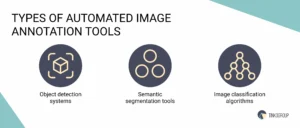
Object detection systems
These systems automatically identify and localize objects within images. They use convolutional neural networks (CNNs) and other deep learning architectures to recognize objects based on patterns and features. Popular object detection frameworks include YOLO (You Only Look Once) and Faster R-CNN (Region-based Convolutional Neural Networks).
Semantic segmentation tools
In fact, these tools segment images into different regions and assign semantic labels to each pixel. These projects provide fine-grained annotation by distinguishing between object classes and backgrounds. DeepLab, U-Net, and Mask R-CNN are this category’s widely used semantic segmentation models.
Image classification algorithms
These algorithms classify entire images into predefined categories or classes. They learn discriminative features from annotated training data and apply them to classify unseen images. CNNs, such as AlexNet, VGG, and ResNet, form the backbone of many image classification systems.
Manual image annotation tool
While automated ones offer speed and efficiency, manual image annotation tools remain necessary for tasks requiring human expertise and nuanced understanding. Manual annotation involves human annotators meticulously labeling images based on specific criteria or guidelines.
Here are some examples of manual image annotation tools:
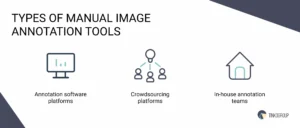
Annotation software platforms
These platforms provide user-friendly interfaces for annotators to label images manually. These solutions offer annotation tools such as bounding boxes, polygons, key points, and brush tools for precise labeling. Examples include LabelImg, Labelbox, and more.
Crowdsourcing platforms
Famous platforms like Amazon Mechanical Turk (MTurk) and Figure Eight (formerly CrowdFlower) enable businesses to outsource image annotation tasks to a distributed workforce. Crowdsourcing offers scalability and diversity in annotation while allowing task management and quality control flexibility.
In-house annotation teams
Some organizations prefer establishing in-house annotation teams comprising trained annotators who manually label images according to project requirements. In-house teams ensure confidentiality, control, and consistency in annotation processes, making them suitable for sensitive or proprietary data.
15 best image annotation tools for your project
Image annotation is a crucial step in enabling the training of models to recognize and understand visual data accurately. Here, we demonstrate a detailed list of the 15 best image annotation tools for computer vision that meet various needs and use cases.
1. Appen
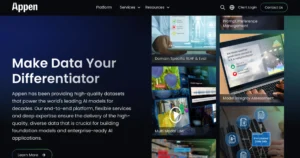
Appen is a leading provider of high-quality annotated data, using a global crowd workforce for accurate annotations at scale. This image annotation tool enables businesses to crowdsource annotations from a global pool of contributors, ensuring scalability and diversity in the annotated data. The platform typically allows clients to customize their annotation tasks according to their specific requirements and provides quality control and validation tools to ensure accurate annotations.
Features:
- Crowdsourced annotation. Utilizes a diverse pool of annotators for precise labeling.
- Customization. Tailors annotation tasks to specific project requirements.
- Quality control. Implements rigorous quality assurance measures for accurate results.
Use cases: object detection, image classification, natural language processing.
2. V7 Labs
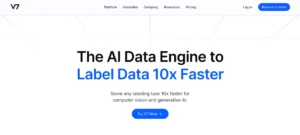
V7 Labs is a company that specializes in computer vision solutions, including image annotation tools. This company offers a platform designed to assist with various annotation tasks required for training machine learning models.
Features:
- AI integration. Uses advanced algorithms for automated annotation.
- Scalability. Manages large datasets with ease for rapid annotation.
- Versatility. Supports various annotation formats including bounding boxes and polygons.
Use cases: autonomous vehicles, robotics, satellite imagery.
3. Scale AI
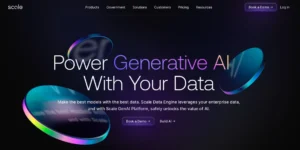
The Scale image annotation tool allows users to add scale rulers or scales to images to provide a visual reference to the dimensions of objects. This feature is handy when analyzing images of complex structures such as small animals or geological formations. In addition to scale rulers, users can enhance images by adding text labels, arrows, and shapes to highlight certain aspects.
Features:
- Human-in-the-loop. Integrates human annotators with AI algorithms for accurate labeling.
- API (application programming interface) integration. Seamlessly integrates with existing workflows via API.
- Project management. Offers dedicated project management and support.
Use cases: medical imaging, retail analytics, self-driving cars.
4. Labelbox
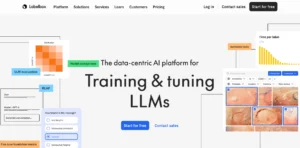
Labelbox is a powerful image annotation tool that is easy to use, fast, and adaptable. Its functionality is perfectly aligned with logical and efficient work processes. Users can quickly integrate the tool into their work, adapting it to teams of any size and generating high-quality training data effortlessly.
Features:
- Collaboration tools. Facilitates teamwork with version control and collaboration features.
- Integration. Compatible with popular ML frameworks for seamless workflow integration.
- Quality assurance. Ensures data quality through robust validation mechanisms.
Use cases: agriculture, drone imagery, industrial automation.
5. SuperAnnotate
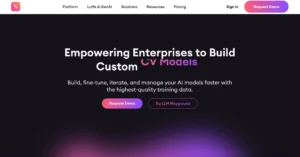
SuperAnnotate is a popular image annotation tool for creating labeled datasets for training machine learning models, particularly in computer vision. It offers a user-friendly interface and a range of annotation capabilities to accommodate various tasks.
Features:
- Smart annotation. Uses AI algorithms for faster annotation without compromising quality.
- Analytics dashboard. Provides insights into annotation progress and project metrics.
- Customization. Tailors annotation workflows to specific project requirements.
Use cases: healthcare imaging, wildlife conservation, retail analytics.
6. CVAT (Computer Vision Annotation Tool)
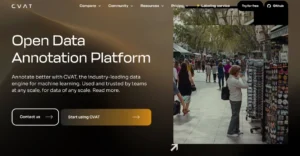
CVAT (Computer Vision Annotation Tool) is a widely used open-source image annotation tool developed by researchers at Intel. CVAT is part of the Viso Suite of computer vision applications and is available to businesses. CVAT supports several additional components: Deep Learning Deployment Toolkit (a component of OpenVINO), NVIDIA CUDA Toolkit, TensorFlow Object Detection API, and others.
Features:
- Open source. Free and customizable tool with active community support.
- Versatility. Supports various annotation types, including bounding boxes and polygons.
- Flexibility. Allows users to create custom annotation pipelines.
Use cases: research, education, small-scale projects.
7. Scalabel
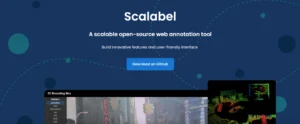
Scalability, flexibility, and ease of use were the primary factors in the development of Scalabel. The image annotation tool prioritizes accuracy by implementing automatic annotations. Collaboration features and version control support allow multiple developers to work on a shared project simultaneously. Quality assurance is enhanced with integrated review, validation, and remediation tools.
Features:
- Distributed annotation. Handles large datasets with distributed annotation capabilities.
- Real-time collaboration. Enables multiple users to annotate simultaneously with real-time synchronization.
- 3D annotation. Supports annotation of 3D point clouds and volumetric data.
Use cases: autonomous driving, augmented reality (AR), robotics.
8. Dataloop
Dataloop is a cloud-based image annotation tool with various applications for automating the data preparation process for retail, robotics, autonomous vehicles, precision agriculture, and more. The Dataloop markup tool works with all kinds of images: pictures and videos. So, you can integrate deep learning models and automate the markup process using pre-trained classes.
Features:
- Automation tools. Integrates AI algorithms for semi-automated annotation workflows.
- Task management. Streamlines annotation tasks with workflow automation and task assignment features.
- Deployment options. Offers flexible deployment options, including cloud and on-premises solutions.
Use cases: robotics, industrial automation, ecommerce.
9. VGG Image Annotator (VIA)
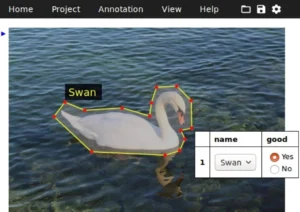
The Visual Geometry Group (VGG) at the University of Oxford has introduced the VGG Image Annotator (VIA), a free and open-source image annotation tool. VIA offers a simple user interface that allows you to draw various shapes on photos, including points, lines, polygons, rectangles, and more. In addition, VIA supports feature annotation, providing additional context for annotations.
Features:
- Ease of use. Simple and intuitive interface for quick annotation tasks.
- Compatibility. Supports various image formats and annotation types.
- Portability. Lightweight and easy to deploy, ideal for small teams and individual use.
Use cases: education, research, prototype development.
10. Roboflow
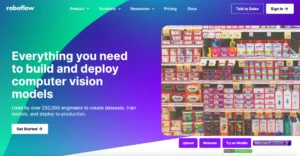
Roboflow is a cloud-based service designed for data annotation and tagging. The platform provides various annotation options, including polygons, semantic segmentation, and bounding boxes. Also, this image segmentation annotation tool is equipped with quality assurance tools that ensure the accuracy and reliability of annotations.
Features:
- Data preprocessing. Streamlines data preprocessing tasks, including annotation and augmentation.
- Integration. It integrates seamlessly with popular machine-learning frameworks and platforms.
- Augmentation library. Provides a rich library of augmentation techniques for enhancing training data.
Use cases: object detection, sentiment analysis, facial recognition.
11. Hasty
Hasty is an online image annotation tool that uses artificial intelligence (AI) to annotate photos. A strategy worth mentioning here is “using AI to train AI,” which involves active learning to improve designed signatures over time. This approach uses advanced technologies to develop more progressive algorithms and models for image annotation.
Features:
- Real-time collaboration. Facilitates teamwork with real-time annotation and feedback capabilities.
- Customization. Allows users to create custom labeling workflows and automation rules.
- Security. Ensures data security and compliance with privacy regulations.
Use cases: security applications, forensics, video analytics.
12. Supervisely
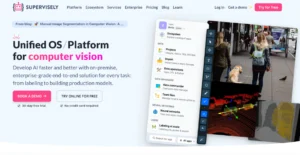
Supervisely is a user-friendly video and image annotation tool for machine vision applications. The platform offers several annotation types, including object identification, segmentation, classification, and tracking, all through an intuitive interface. The Supervisely annotation engine enhances the annotation process with automated polygon segmentation, shape manipulation, text manipulation, and basic labeling.
Features:
- Deep learning workflow. Provides annotation, training, and deployment tools in a single platform.
- AI assistance. Uses AI algorithms for efficient annotation and model training.
- Pre-trained models. Offers pre-trained models and plugins for various use cases.
Use cases: healthcare imaging, manufacturing, satellite imagery.
13. RectLabel
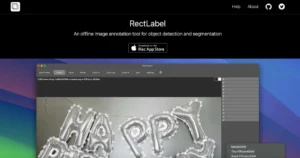
RectLabel is an image annotation tool for machine learning applications. This universal tool supports annotations, including bounding boxes, polygons, and lines. Its user-friendly interface makes it accessible to people of all skill levels, allowing users to annotate images by drawing bounding boxes around relevant objects.
Features:
- User-friendly interface. Simple and intuitive interface suitable for beginners.
- Batch processing. Supports batch processing for efficient annotation of multiple images.
- Export options. Allows users to export annotations in various formats for compatibility with different platforms.
Use cases: retail analytics, inventory management, object tracking.
14. Keylabs
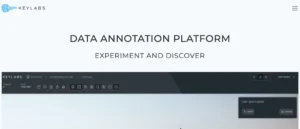
Keylabs empowers users by providing a universal platform for annotating images with captions, tags, and various information, including bounding boxes, critical points, and semantic segmentation. This image annotation tool is handy for AI researchers and developers as it simplifies image annotation and saves time.
Features:
- Expert annotation. Provides annotations by domain experts with specialized knowledge.
- Quality control. Implements stringent quality control measures for accurate labeling.
- Flexibility. Offers customizable annotation solutions to meet specific project requirements.
Use cases: medical imaging, agriculture, geospatial analysis.
15. Make Sense AI
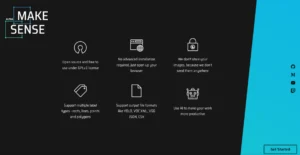
Make Sense AI is a web-based photo tagging application that requires no download or installation. Since this image annotation tool is browser-based, it eliminates the need for complex setup procedures. The platform uses TensorFlow.js, one of the most popular frameworks for training neural networks, which serves as the basis for Make Sense AI.
Features:
- AI assistance. Employs AI algorithms for smart annotation and labeling suggestions.
- Integration. Seamlessly integrates with machine learning pipelines for training and deployment.
- User-friendly interface. A simple and intuitive interface suitable for all skill levels.
Use cases: retail analytics, facial recognition, content moderation.
Guide on selecting the advanced image annotation tool
If you are training algorithms for object detection, image classification, or semantic segmentation, choosing the right annotation tool is critical to the success of your project. Let’s explore the key factors when selecting an image annotation tool for machine learning.
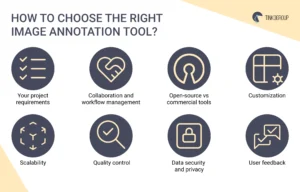
Your project requirements
Before exploring the many annotation tools available, it is crucial to understand your project’s specific requirements. Consider factors such as the type and complexity of annotations needed, the size of your dataset, and any unique constraints or challenges.
For instance, if your project involves annotating medical images with intricate details, you’ll require a tool capable of handling precise annotations and supporting medical imaging formats.
Collaboration and workflow management
Efficient collaboration and workflow management are essential, especially in team-based projects or with distributed teams. You can look for annotation tools that facilitate seamless collaboration, allowing multiple annotators to work simultaneously on the same dataset.
Features like version control, task assignment, and real-time updates can streamline annotation and enhance productivity.
Open-source vs commercial tools
The choice between open-source and commercial image annotation tools depends on various factors, including budget, customization requirements, and support. Open-source tools offer flexibility and cost-effectiveness but may lack certain advanced features or dedicated support channels.
On the other hand, commercial tools often provide a more polished user experience (UX), comprehensive support, and additional functionalities tailored to specific industries or use cases.
Customization
In general, every project has unique requirements, and your annotation tool should offer sufficient customization options to accommodate them. It is a great idea to look for tools that allow you to define custom annotation types, create customized workflows, and integrate with existing tools or systems seamlessly. The ability to adapt the tool to your project’s specific needs can significantly enhance its effectiveness and efficiency.
Scalability
It is crucial to consider if you deal with large datasets or anticipate future expansion. You can choose an annotation tool that can scale with your project, accommodating an increasing volume of data and users without compromising performance.
Cloud-based solutions and distributed architectures are often better equipped to handle scalability challenges than standalone or on-premises tools.
Quality control
Maintaining annotation quality is essential to ensure the accuracy and reliability of your machine-learning models. So, look for annotation tools that offer robust quality control mechanisms, such as validation workflows, inter-annotator agreement metrics, and error detection tools.
Additionally, features like audit trails and revision history can help track changes and identify discrepancies, enabling you to maintain high-quality annotations throughout the project lifecycle.
Data security and privacy
Protecting sensitive data is crucial, mainly when working with proprietary or confidential information. Choose annotation tools that prioritize data security and privacy, implement encryption, implement access controls, and comply with relevant regulations such as GDPR (The General Data Protection Regulation) or HIPAA (The Health Insurance Portability and Accountability Act).
Cloud-based solutions should adhere to industry best practices for data protection and offer assurances regarding data sovereignty and confidentiality.
User feedback
Finally, the user experience must be considered, and feedback from potential annotators or end-users must be gathered before making a decision. An intuitive and user-friendly interface can significantly impact productivity and user satisfaction. You can look for annotation tools that prioritize usability, offer comprehensive documentation and support resources, and incorporate user feedback into their development roadmap.
In conclusion, selecting the right image annotation tool requires careful consideration of various elements. By evaluating these factors comprehensively and prioritizing the features that align with your project goals, you can choose an annotation tool that enhances productivity, ensures annotation quality, and accelerates the development of your machine-learning models.
Tinkogroup’s experience in employing image annotation tools
As a leading player in data annotation services, Tinkogroup recognized the critical role of high-quality labeled data in training robust AI models. With a diverse range of projects spanning computer vision and autonomous systems, we understand the sophistication of annotating vast quantities of images accurately and efficiently. This realization drives us to explore cutting-edge image annotation tools to streamline our annotation workflows and elevate the quality of our datasets.
One of the most significant advantages we gain from employing image annotation tools for computer vision is the powerful reduction in annotation time. Traditional manual annotation methods are time-consuming, often leading to blockages in project timelines. However, with the advanced annotation tools using techniques such as semantic segmentation, bounding boxes, and landmark detection, we’ve witnessed exponential improvements in annotation speed without compromising accuracy.
Moreover, image annotation tools allow us to maintain consistency and standardization across our datasets. By automating redundant annotation tasks and providing intuitive interfaces for human annotators, these tools ensure equality in labeling conventions, thus enhancing the reliability and reproducibility of our AI models. This consistency is crucial in applications where precise illustration of objects or structures is vital, such as object detection systems.
At Tinkogroup, we employ various data annotation software, including CVAT, Labelbox, Imglab, etc. Let’s analyze Imglab in more detail.
Imglab
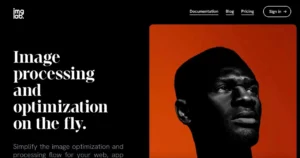
Imglab is a mark of innovation in the domain of image annotation tools. It offers a sophisticated yet user-friendly platform that empowers companies to annotate images precisely and efficiently.
Moreover, Imglab operates on a seamless and intuitive workflow designed to streamline the annotation process from start to finish. Here’s an analysis of its functioning:
- Upload and organize: Users can effortlessly upload their image datasets onto the Imglab platform, organized into customizable projects and folders for easy management.
- Annotation tools: Imglab provides various annotation tools, including bounding boxes, polygons, key points, and semantic segmentation masks. These tools enable users to annotate objects of interest with exceptional accuracy and granularity.
- Collaboration and review: This platform facilitates collaboration among team members by allowing them to annotate images simultaneously and exchange feedback in real time. Additionally, built-in review features enable quality control and validation of annotations to ensure data accuracy.
- Export and integration: Once annotations are complete, users can seamlessly export labeled datasets in formats compatible with popular machine learning frameworks and applications, such as TensorFlow, PyTorch, and COCO.
Imglab distinguishes itself through a rich set of features tailored to meet the diverse needs of users across industries. Here are some key features that set Imglab apart:
Customizable workflows
Imglab allows users to tailor annotation workflows to suit their specific requirements, whether object detection, image segmentation, or keypoint annotation.
AI assistance
Using artificial intelligence, Imglab offers intelligent suggestions and auto-annotation capabilities to expedite the annotation process and reduce manual effort.
Version control
With built-in version control mechanisms, Imglab enables users to track changes, revert to previous versions, and maintain a comprehensive audit trail of annotations for enhanced traceability and accountability.
Quality assurance tools
Imglab incorporates advanced quality assurance tools, such as annotation validation metrics and inter-annotator agreement analysis, to ensure the accuracy and consistency of annotations across datasets.
Scalability and performance
Designed to handle large-scale annotation projects with ease, Imglab has robust infrastructure scalability and high-performance computing capabilities to accommodate growing datasets and user demands.
Choose your best image annotation tool
Combining human experience and automated processes is crucial in machine learning and data annotation. Completing the human annotation is the basis for the project’s next stage, in which the machine learning model comes into play, automatically examining the labeled images to create annotations. This approach not only simplifies the process of creating annotations but also emphasizes the symbiosis of human and artificial intelligence.
Ready to revolutionize your image annotation process? Contact us to explore how our cutting-edge data annotation services can elevate your workflow. Let’s collaborate to turn your vision into reality!
FAQ
What is the best image annotation tool?
The best image annotation tool ultimately depends on your specific needs. Some popular options include Labelbox, VGG Image Annotator, CVAT, and more. When choosing the right tool for your project, consider factors like user interface, annotation capabilities, and collaboration features.
How do you automatically annotate images for object detection?
Automatic image annotation for object detection typically involves machine learning algorithms, such as object detection models trained on large datasets. YOLO (You Only Look Once) and OpenCV provide frameworks and pre-trained models that can automatically annotate images for object detection tasks.
What features should I look for in an image annotation tool?
Consider features such as support for various annotation types (bounding boxes, polygons), compatibility with various image formats, ease of use, collaboration capabilities (such as version control and team collaboration), support for custom attributes, and integration with other tools or platforms.
What is the best free image annotation tool?
Several free image annotation tools, like Labellmg and COCO Annotator, offer robust functionalities. These tools provide essential annotation features without requiring any financial investment.
How do I make an image annotation?
You can use image annotation software to annotate an image manually. These tools typically allow you to draw bounding boxes, polygons, or key points around objects of interest within an image.
What is the auto-annotation tool for images?
Auto-annotation tools for images employ machine-learning algorithms to automatically generate annotations for objects within images. These solutions are handy for accelerating the annotation process in large-scale projects.

